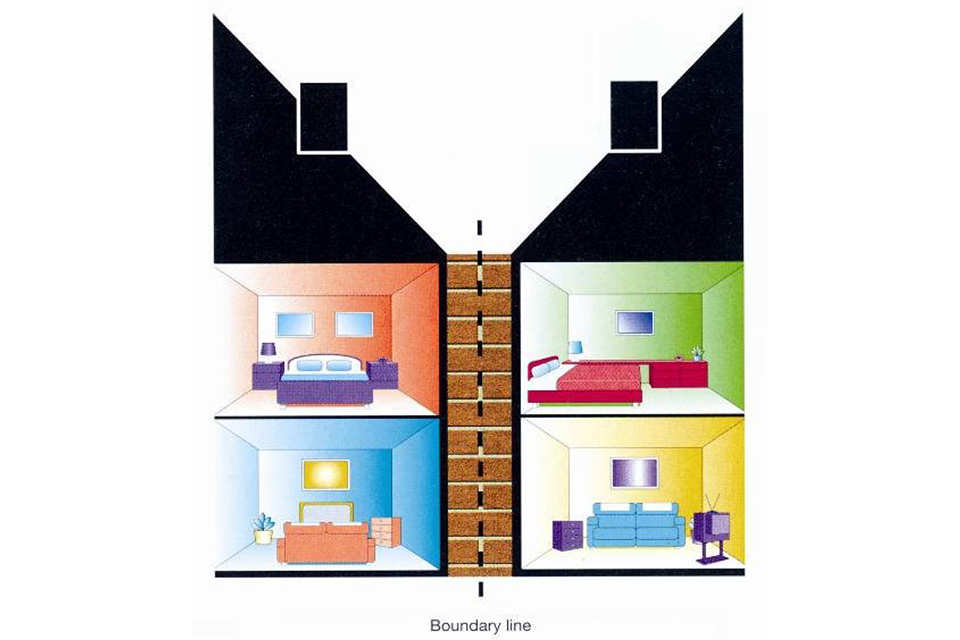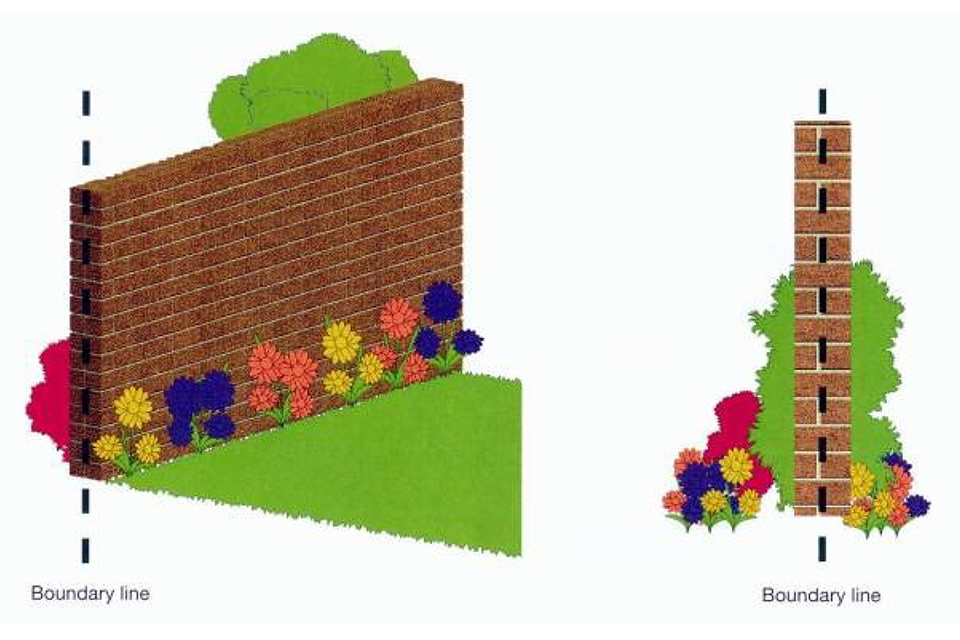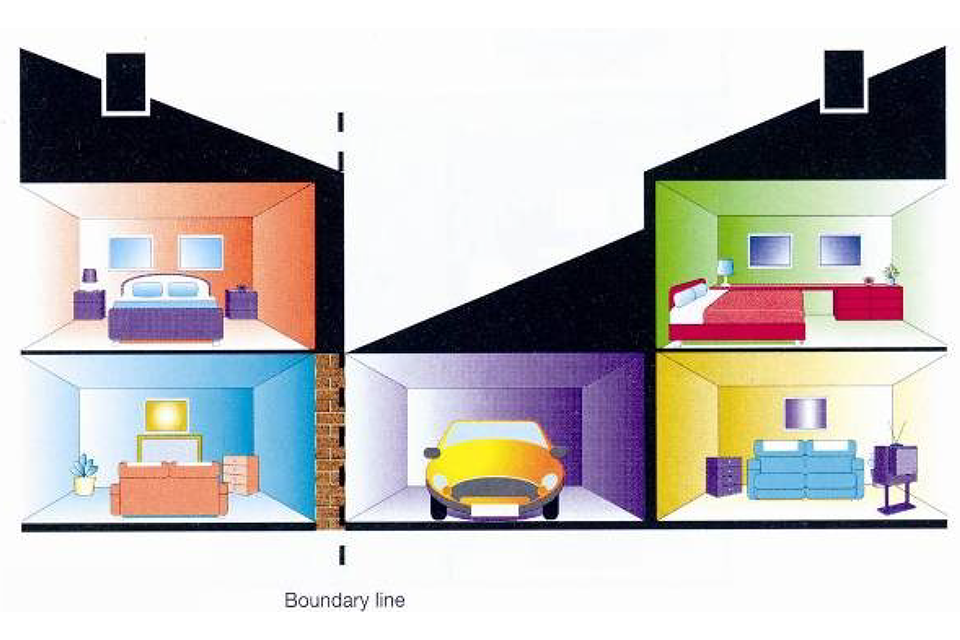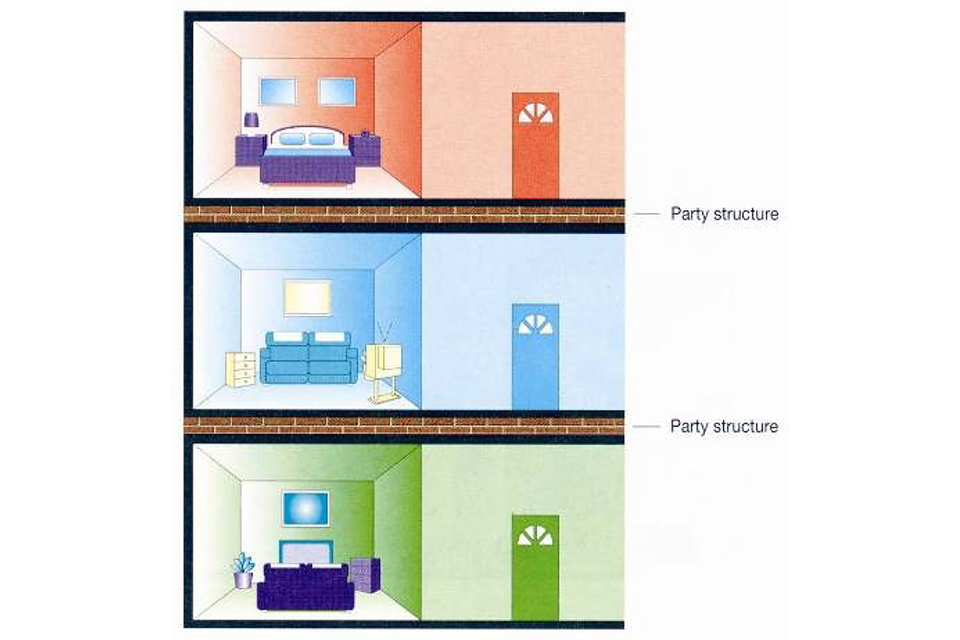The Party Wall etc 1996
Introduction
It aims to explain in simple terms how the Party Wall etc. Act 1996 (“the Act”) may affect someone who either wishes to carry out work covered by the Act (the “Building Owner”) or receives notification under the Act of proposed adjacent work (the “Adjoining Owner”).
Under the Act, the word “owner” includes the person(s), company or other body:
- holding the freehold title
- holding a leasehold title for a period exceeding one year
- under contract to purchase such a freehold or leasehold title
- entitled to receive rents from the property
There may therefore be more than one “owner” of a single property.
This booklet is only about the Act, which is separate from planning or building regulations control. You must remember that reaching agreement with the Adjoining Owner or owners under the Act does not remove the possible need to apply for planning permission and/or to comply with building regulations procedures. Conversely, gaining planning permission or complying with the building regulations does not remove the need to comply with the Act where it is applicable.
If you intend to carry out building work which involves one of the following categories:
- building a free standing wall or a wall of a building up to or astride the boundary with a neighbouring property (section 1 of the Act)
- work on an existing party wall or party structure (see paragraph 3 below) or building against such a party wall or party structure (section 2 of the Act)
- excavating near a neighbouring building (section 6 of the Act)
you must find out whether that work falls within the Act. If it does, you must notify all Adjoining Owners.
If work starts without a notice being given, an adjoining owner can seek to stop the work through a court injunction or seek other legal redress.
1. What does the Act do?
The Act came into force on 1 July 1997 and applies throughout England and Wales. (The Act does not apply to Scotland or Northern Ireland).
The Act provides a framework for preventing or resolving disputes in relation to party walls, party structures, boundary walls and excavations near neighbouring buildings.
Anyone intending to carry out work (anywhere in England and Wales) of the kinds described in the Act must give Adjoining Owners notice of their intentions. The Act applies even to Crown, government and local authority owned property.
Where the intended work is to an existing party wall (section 2 of the Act) a notice must be given even where the work will not extend beyond the centre line of a party wall.
Note: A party wall may not necessarily have a boundary running through its centre line for the whole of its length but for only part of its length.
It is often helpful in understanding the principles of the Act if owners think of themselves as joint owners of the whole of a party wall rather than the sole owner of half or part of it.
Adjoining Owners can agree with the Building Owner’s proposals or reach agreement with the Building Owner on changes in the way the works are to be carried out, in their timing and manner. Where a dispute arises in relation to a new party wall or party fence wall under section 1, and where there is no written consent by the Adjoining Owner within fourteen days to a notice served in relation to an existing structure under section 2 or an excavation under section 6.
2. What does the Act cover?
- Various work that is going to be carried out directly to an existing party wall or party structure (see paragraphs 4 to 20
- New building at or astride the boundary line between properties (see paragraphs 22 to 26
- Excavation within 3 or 6 metres of a neighbouring building(s) or structure(s), depending on the depth of the hole or proposed foundations (see paragraphs 28 to 30).
Work may fall within more than one of the above categories and involve different types of buildings and structures for example, houses, garages and office buildings.
If you are not sure whether the Act applies to the work that you are planning, you may wish to seek professional advice. Contact information for bodies that may be able to provide assistance can be found in Part 6 of this booklet. However, any advice given should not be seen as being endorsed by the Department for Levelling Up, Housing and Communities.
3. What is a party wall?
The Act recognises two main types of party wall.
Party wall type A
A wall is a “party wall” if it stands astride the boundary of land belonging to two (or more) different owners.
Such a wall:
- is part of one building (see diagram 1)
- or separates two (or more) buildings (see diagram 2)
- or consists of a “party fence wall” (see diagram 3)
A wall is a “party fence wall” if it is not part of a building, and stands astride the boundary line between lands of different owners and is used to separate those lands (for example a masonry garden wall). This does not include such things as wooden fences or hedges.
Party wall type B
A wall is also a “party wall” if it stands wholly on one owner’s land, but is used by two (or more) owners to separate their buildings (see diagram 4).
An example would be where one person has built the wall in the first place, and another has built their building up against it without constructing their own wall.
Only the part of the wall that does the separating is “party” – sections on either side or above are not “party”.
The Act also uses the expression “party structure”. This is a wider term, which could be a wall or floor partition or other structure separating buildings or parts of buildings approached by separate staircases or entrances for example flats (see diagram 5).
Walls that are not Party Walls:
These may include boundary walls (a fence wall/garden wall built wholly on one owner’s land) and external walls (the wall of a building built up to but not astride the boundary).

Diagram 1

Diagram 2

Diagram 3

Diagram 4

Diagram 5
If you are not sure whether the Act applies to the work that you are planning, you may wish to seek professional advice. Contact information for bodies that may be able to provide assistance can be found in Part 6 of this booklet. However, any advice given should not be seen as being endorsed by the Department for Levelling Up, Housing and Communities.
Part 2: Building owners
4. What are my rights I want to do work on an existing party wall?
The Act provides a Building Owner, who wishes to carry out various sorts of work to an existing party wall, with additional rights going beyond ordinary common law rights.
Section 2 of the Act lists what work can be done. The most commonly used rights are:
- to repair a party wall
- to insert a damp proof course
- to underpin the whole thickness of a party wall (for example, to prevent settlement)
- to cut into a party wall to take the bearing of a beam (for example for a loft conversion)
- to raise the height of a party wall (for example, adding another storey)
- to extend a party wall downwards (for example, to form a basement)
- to demolish and rebuild a party wall (for example, if it is structurally defective)
- to underpin the whole thickness of a party wall (for example, to form a basement)
- to cut off projections from a party wall (or from an adjoining owner’s boundary or external wall) if necessary to build a new wall adjacent to that wall (for example, removing a chimney breast)
5. What are my duties under the Act?
If you intend to carry out any of the works mentioned in section 2 of the Act (see paragraph 4 for the most common works), you must inform all Adjoining Owners – see paragraphs 7 and 8. You must not even cut into your own side of the wall without telling the Adjoining Owners of your intentions – but see paragraph 6.
The Act contains no enforcement procedures for failure to serve a notice. However, if you start work without having first given notice in the proper way, Adjoining Owners may seek to stop your work through a court injunction or seek other legal redress. An Adjoining Owner cannot stop someone from exercising the rights given to them by the Act, but may be able to influence how and at what times the work is done – see paragraph 10.
The Act also says that a Building Owner must not cause unnecessary inconvenience. This is taken to mean inconvenience over and above that which will inevitably occur when such works are properly undertaken.
The Building Owner must provide temporary protection for adjacent buildings and property where necessary. The Building Owner is responsible for making good any damage caused by the works or must make payment in lieu of making good if the Adjoining Owner requests it.
Where party walls and structures are modified, repaired, or demolished and rebuilt (s.2(2)(a) and (b) of the Act) section 11(4) and (5) provides that the cost of the work shall be shared where the work is necessary on account of defect or want of repair, in proportion to the use each party makes of the structure or wall and the responsibility of each for the defect or want of repair concerned.
Where use is made of party walls previously built at the cost of the Adjoining Owner, the Act makes provision for a fair payment to be made to the Adjoining Owner.
6. What about things like putting up shelves or wall units, or installing recessed electric sockets, or removing and renewing plaster?
Some works on a party wall may be so minor that service of notice under the Act would be generally regarded as not necessary.
Things like:
- drilling into a party wall to fix plugs and screws for ordinary wall units or shelving
- cutting into a party wall to add or replace recessed electric wiring and sockets
- removing old plaster and replastering
may all be too minor to require a notice under the Act.
However, the key point is whether your planned work might have any possible consequences for the structural strength and support functions of the party wall as a whole, or cause damage to the Adjoining Owner’s side of the wall. If you are in doubt about whether your planned work requires a notice you might wish to seek advice from a qualified building professional.
7. Who counts as an “Adjoining Owner”?
Essentially, an Adjoining Owner is anyone who is an owner of land, buildings or rooms adjoining those of the building owner, which may include the local authority.
Also, for the purposes of section 6 of the Act a property shall be deemed to be adjoining if it is within the relevant distance even if it is nor actually adjoining.
The adjoining property may have a freehold owner, or a leasehold owner all of whom may be an ‘Adjoining Owner’ under the Act. Where there is more than one owner of the property, or more than one adjoining property, it is your duty to notify all Adjoining Owners.
8. How do I inform the Adjoining Owner or owners?
It is obviously best to discuss your planned work fully with the Adjoining Owners before you (or your professional adviser on your behalf) give notice, in writing, about what you plan to do. If you have already ironed out possible snags with your neighbours, this should mean that they will readily give consent in response to your notice. You do not need to appoint a professional adviser to give the notice on your behalf, however if you do you should satisfy yourself as to the experience and professional qualifications of your adviser.
Whilst there is no official form for giving notice under the Act, your notice will need to include the following details:
- your own name and address (joint owners must all be named, e.g. Mr A & Mrs B Owner)
- the address of the building to be worked on (this may be different from your main or current address)
- a full description of what you propose to do (it may be helpful to include plans, and you must do so in respect of excavation works, but you must still describe the works)
- when you propose to start (which must not be before the relevant notice period has elapsed)
The notice should be dated and it is advisable to include a clear statement that it is a notice under the provisions of the Act.
You may want to base your notice on Example Letter 1, set out in Part 5 of this booklet.
You may deliver the notice to the Adjoining Owner(s) in person, send it by post, or send it by email if the adjoining owner has stated a willingness to receive the notice by email and has provided an email address. Alternatively, if you do not know the name of the owner and/or the property is rented out you may address the notice to “The Owner”, adding the address of the premises, and deliver it to a person on the premises, or, if the neighbouring property is empty, fix it to a conspicuous part of the premises.
9. How long in advance do I have to serve the notice?
At least two months before the planned starting date for work to the party wall. The Adjoining Owner may agree to allow works to start earlier but is not obliged to even when agreement on the works is reached. The notice is only valid for a year, so do not serve it too long before you wish to start.
10. What happens after I serve notice?
A person who receives a notice about intended work may:
- give his consent in writing, or
- refuse to consent to the works proposed (the dispute resolution procedure explained in paragraph 12 of this booklet then comes into play), or
- do nothing
If, after a period of 14 days from the service of your notice, the person receiving the notice has done nothing, a dispute is deemed to have arisen – see paragraphs 12 to 19.
As suggested in paragraph 8, your notice should not come as a surprise. If you have already ironed out possible snags with your neighbours, this should mean that they will more readily give consent in response to your notice.
It should be noted that where consent is given you are not relieved of your obligations under the Act, for example to avoid unnecessary inconvenience or to provide temporary protection for adjacent buildings and property where necessary. The notice of consent is simply confirmation that, at that time, there is nothing ‘in dispute’. Should a difference arise at a later date (for example in respect of damage caused) the procedure in paragraph 12 then comes into play.
11. What happens if I receive a counter-notice?
A person who receives notice about intended work may, within one month, give a counter-notice setting out what additional or modified work he would like to be carried out for his own benefit, and accompanied by all necessary particulars. A person who receives a notice, and intends to give a counter-notice, should however let the Building Owner know within 14 days.
If you receive a counter-notice you must respond to it within 14 days otherwise a dispute is deemed to have arisen – see paragraph 12.
12. What if I cannot reach agreement with the Adjoining Owners on the work to be done to the party wall?
The best way of settling any point of difference is by friendly discussion with your neighbour. Agreements should always be put in writing.
If you cannot reach agreement with the Adjoining Owners, the next best thing is to agree with them on appointing what the Act calls an “Agreed Surveyor” to draw up an “Award”. The surveyor must be a person agreed between the owners to act.
Alternatively, each owner can appoint a surveyor to draw up the award together. The two appointed surveyors will select a third surveyor (who would be called in only if the two appointed surveyors cannot agree or either of the owners or either surveyor calls upon the third surveyor to make an award).
In all cases, surveyors appointed or selected under the dispute resolution procedure of the Act must consider the interests and rights of both owners and draw up an award impartially.
Their duty is to resolve matters in dispute in a fair and practical way.
Where separate surveyors are appointed by each owner, the surveyors must liaise with their appointing owners and put forward the respective owners’ preferred outcome. However, beyond that the surveyors do not act as representatives for the respective owners. They must always act consistently with the terms of the Act to reach a fair and impartial award.
13. Who can I appoint as a surveyor in the event of a dispute?
The term “surveyor” under the Act can include any person who is not a party to the matter. This means that you can appoint almost anyone you like to act in this capacity. However, the person should not have already been engaged to supervise the building work. The surveyor should also have a good knowledge of construction and of procedures under the Act. You cannot however act for yourself.
Some people are obviously more suitable than others. You may wish to look for a qualified building professional with some experience or knowledge of party wall matters – see Part 6, Further Information, at the end of this booklet.
14. What does the surveyor do?
The surveyor (or surveyors) will settle the matter by making an “award” (also known as a “party wall award”). This is a document which:
- sets out the work that will be carried out
- says when and how the work is to be carried out (for example to limit continuous periods of time when excessively noisy work can be carried out)
- specifies any additional work required (for example necessary protection to prevent damage)
- often contains a record of the condition of the adjoining property before the work begins (so that any damage to the adjoining land or buildings can be properly attributed and made good)
- allows access for the surveyor(s) to inspect the works while they’re going on as may be necessary (to see that they are in accordance with the award)
It is a good idea to keep a copy of the award with your property deeds when the works are completed.
15. Who pays the surveyor’s fees?
Usually the Building Owner will pay all costs associated with drawing up the award including the adjoining owner’s surveyor’s fees, if the works are solely for the Building Owner’s benefit.
However, in certain circumstances where work is necessary due to defect or need of repair the adjoining owner may have to pay costs. In these circumstances the costs are split based on the use each owner has of the structure or wall concerned and responsibility for the defect or need of repair if more than one owner makes use of the structure or wall concerned.
The surveyor (or surveyors) will decide who pays the fees for drawing up the award and for checking that the work has been carried out in accordance with the award.
16. How much will a surveyor cost?
Surveyor’s fees are a matter for individual surveyors. There are no set charges. It is for clients to negotiate fees with the surveyor(s).
The Act provides for surveyors to be paid the reasonable costs of drawing up an award. However, if the owner or the adjoining owner feels that a surveyor’s costs are unreasonable they may ask for a breakdown of costs, e.g. the hourly rate and number of hours of time being charged for.
17. Is the surveyor’s award final?
The Award is final and binding unless it is rescinded or modified by a county court on appeal. Each owner has 14 days from service of the award on them to appeal to the county court against the award.
An appeal should not be undertaken lightly, and an unsuccessful appellant may incur an award of costs against them. An owner considering an appeal may well wish to seek legal advice.
18. Who pays for the building works?
Your agreement with the Adjoining Owner, or the award in the event of a dispute, will set this out.
The general principle in the Act is that the Building Owner who initiated the work pays for it if the works are solely for his benefit.
However, there are cases where the Adjoining Owner should pay part of the expense of the works. This is set out in section 11 of the Act and is for the surveyor to determine. It covers for example:
- where work to a party wall is needed because of defects or lack of repair for which the Adjoining Owner may be responsible (in full or in part)
- where an Adjoining Owner requests that additional work should be done for his benefit
19. What happens if the neighbours won’t cooperate?
If a dispute has arisen and the neighbouring owner refuses or fails to appoint a surveyor under the dispute resolution procedure, you will not be able to appoint an “agreed surveyor”.
In these circumstances you can appoint a second surveyor on the neighbouring owner’s behalf, so that the procedure can go ahead – see paragraphs 12 and 13. Your own surveyor will advise you on the appointment of a second surveyor on behalf of the Adjoining Owner.
20. What about access to neighbouring property?
Under the Act, an Adjoining Owner and/or occupier must, when necessary, let in your workmen and your own surveyor or designer etc., to carry out works in pursuance of the Act (but only for those works), and allow access to any surveyor appointed as part of the dispute resolution procedure.
You must give the Adjoining Owner and occupier notice of your intention to exercise these rights of entry. The Act says that 14 days’ notice must be given, except in case of emergency. If access is necessary to carry out the notified works you may wish to include this requirement in the notice that you serve when seeking consent to carry out the works, so as to avoid any dispute in this respect at a later stage when work is underway.
It is an offence, which can be prosecuted in the magistrates’ court, for the occupier or other person to refuse entry to or obstruct someone who is entitled to enter premises under the Act, if the first-mentioned person knows or has reasonable cause to believe that the latter person is entitled to be there.
If the adjoining property is closed (for example an unoccupied property) your workmen and your own surveyor or designer etc. may enter the premises by breaking open a fence or door, if they are accompanied by a police officer after following the Act’s procedures.
You should discuss access for works with your neighbour. It is often in the best interests of the Adjoining Owner to allow access voluntarily to build a wall or to carry out works for which there is no statutory right of access, as this will allow a better finish to the side of the wall that they will see.
20. What about access to neighbouring property?
Adjoining Owners’ rights are described in Part 3 of this booklet. They include the right to:
- appoint a surveyor to resolve any dispute
- require reasonably necessary measures to be taken to protect their property from foreseeable damage and for their security
- not to be caused any unnecessary inconvenience
- be compensated for any loss or damage caused by relevant works
- ask for security for expenses before you start work under the Act so as to guard against the risk of being left in difficulties if you stop work at an inconvenient stage
New building on the boundary line between neighbouring pieces of land (Section 1 of the Act)
22. What does the Act say if I want to build up against or astride the boundary line?
If you plan to build a party wall or party fence wall astride the boundary line, you must inform the Adjoining Owner by serving a notice – see paragraphs 7 and 8. You may want to base your notice on Example Letter 4. However, there is no right to build astride the boundary without your neighbour’s consent in writing – seeparagraph 24.
You must also inform the Adjoining Owner by serving a notice if you plan to build a wall wholly on your own land but up against the boundary line. You may want to base your notice on Example Letter 6.
The Act contains no enforcement procedures for failure to serve a notice. However, if you start work without having first given notice in the proper way, Adjoining Owners may seek to stop your work through a court injunction or seek other legal redress.
23. How long in advance do I have to serve the notice?
At least one month before the planned starting date for building the wall. The notice is only valid for a year, so do not serve it too long before you wish to start.
24. What happens after I serve notice about building astride the boundary line?
If the Adjoining Owner consents within 14 days to the building of a new wall astride the boundary line, the work (as agreed) may go ahead. The expense of building the wall should be shared between the owners in proportion to the use of that wall made or to be made by each owner.
The consent must be by a notice in writing. It is strongly advisable that it should record details of the location of the wall, the allocation of costs and any other agreed terms.
If the Adjoining Owner does not consent in writing within 14 days to the proposed new party wall astride the boundary line, you will be obliged to build the wall wholly on your own land, and wholly at your own expense. You will have to compensate any Adjoining Owner for any damage to his property caused by the building of the wall, or the placing of footings and foundations under his land. There is no right to place “special foundations” (see Appendix A) under his land without his written consent.
You may start work one month after your notice was served, or earlier by agreement.
25. What happens after I serve notice about building up against the boundary line?
Unless your neighbour objects, you may start work one month after your notice was served.
The wall will be built wholly at your own expense and you will have to compensate any Adjoining Owner for any damage to his property caused by the building of the wall, or the placing of footings and foundations under his land. There is no right to place “special foundations” (see Appendix A) under his land without his written consent, and the placing of normal projecting foundations can only be done if it is necessary.
The above information is taken from The Party Wall etc Act 1996: explanatory booklet
Why Choose Our Service

20 Years Of Experience
We provide clear expert advice. Party wall surveyors have a duty to the Act and must act impartially rather than act for the individuals instructing them.

Fully Qualified
Our surveyors are all fully qualified experienced surveyors who are either full members of the Chartered Institute of Building (MCIOB) or full members of the Royal Institute of Chartered Surveyors (RICS)